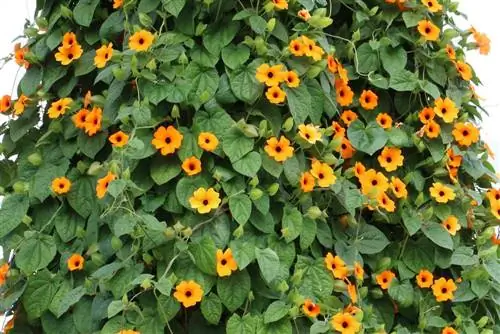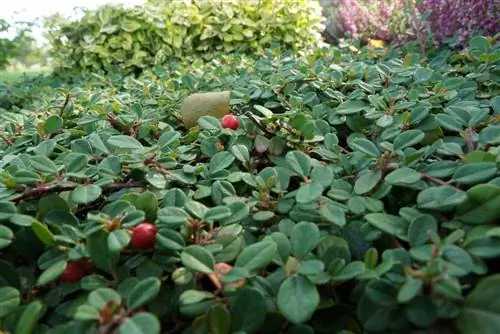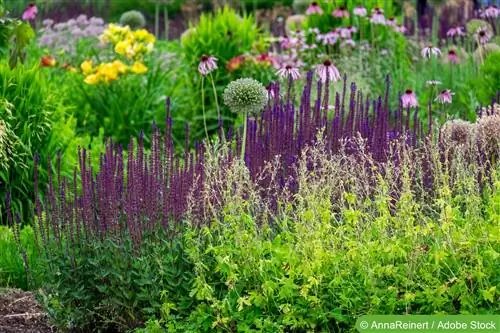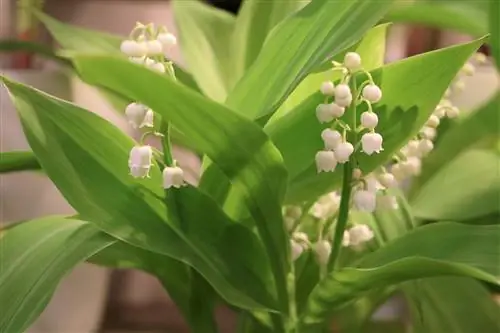- Author admin [email protected].
- Public 2023-12-17 03:39.
- Last modified 2025-01-24 12:45.
Green fern leaves and colorful trumpet flowers? The garden gloxinia can actually do both. Therefore, in common usage it is also called the flowering fern. But the plant is not at all related to the real fern. Doesn't matter. With this impressive combination of leaves and flowers, the name and origin are irrelevant anyway. The more important question is: How do you care for this false fern to bloom?
Species and occurrence
The outdoor gloxinia family includes 14 different species. These trumpet plants mostly come from high- altitude regions in Asia. The majority are tropical trees. The herbaceous At Incarvillea delavayi also feels at home in temperate zones. We have a number of varieties on offer, all of which look a little different from each other.
- also known as Chinese trumpet flower
- Perennial grows 40 to 60 cm high
- mostly blooms in June and July
- white or pink flowers, yellow throat
- “Deli Rose” blooms pink and is ideal for a rock garden
- “Alba” has white flowers
- Incarvillea olgae grows taller
- other varieties: Incarvillea mairei, Incarvillea grandiflora and others
Note:
Houseplants cultivated under the name Gloxinia belong to a completely different genus.
Location
Outdoor gloxinias are plants that can be used flexibly. Your tubers feel at home both in pots and in the garden soil. The only important thing is that they always get enough light, moisture and a handful of nutrients.
- Sunny and partially shaded locations offer sufficient light
- Suitable for perennial beds and rock gardens
- in the neighborhood with cushion asters, spars and delphiniums
- in pots on the terrace and balcony
Floor
Light, humus-rich soil is well suited for the flowering fern. The pH value should be in the neutral to slightly acidic range. The ideal soil for the gloxinia tubers should also be able to store moisture, as this plant does not like drought.
- normal garden soil
- or mixture of sand and clay
- pH value at around 5-7
- medium nutrient content
Tip:
Some species of Gloxinia are also content with calcareous soil. If you can only offer such soil, you don't have to miss out on a flowering fern. Ask the store for a suitable variety.
Plants
Newly purchased tubers or plants can enter their permanent outdoor home from mid-May, when there are no more frosts.
- Loose the soil well. Remove larger stones and old roots.
- Check the soil quality. Add some sand if the soil is too heavy.
- A soil that tends to become waterlogged requires drainage. Use gravel, clay or coarse sand.
- Enrich poor soil with potting soil or compost to increase nutrient levels.
- Now dig a planting hole about 5 cm deep for each tuber. The distance between individual plants should be 20 to 30 cm.
- Insert the tubers and cover them with soil.
- Water the freshly planted gloxinias well.
Tip:
The garden gloxinia does not grow into a huge perennial. As a solitary plant, it can easily disappear visually. Only planting several tubers will give it the attention it deserves.
Advancing the tubers
Garden gloxinias are usually sold in stores as tubers. They can be planted directly in the garden bed as described above. The first thing they face is the time of expulsion. The flowering will have to wait for several more weeks. However, this waiting time can be shortened considerably if the tubers are allowed to sprout in warm rooms from March onwards.
- Start pre-cultivation from March
- in large pots from 20 cm in diameter
- plant in loose potting or garden soil
- Keep soil moist, but not too wet
- only water more when the shoots appear
- ideal temperature is 18 to 22 degrees Celsius
- plant from mid-May
Note:
The tuber only sprouts if it is planted vertically. The “fingers” must point downwards.
Blooming fern as a pot culture
Chinese trumpet flower can also thrive in a pot, but then requires more attention:
- use a mixture of soil, sand and humus as a substrate
- Drainage layer made of expanded clay or gravel protects against waterlogging
- water regularly
- Administer liquid fertilizer via irrigation water every 2-3 weeks
- Cut spent flowers as soon as possible
Pouring
The flowering fern likes moist soil, but it does not cause waterlogging. If the moisture persists, the tubers can rot.
- water regularly during dry periods
- Don't get the leaves wet
- Water only directly in the root area
- Prevent waterlogging at all costs
- There is a high risk of evaporation in sunny places
- Protect the root base from drying out with a layer of mulch
Fertilize

The Incarvillea is a modest consumer of nutrients. In this respect, their care is gardener-friendly. It is sufficient to replenish the nutrient depot every now and then.
- humus soil forms a good basis
- Giving compost in spring provides replenishment
- alternatively spread long-term fertilizer
- z. B. with horn shavings or blue grain
Cutting
Flowering fern does not require pruning. Only dead stems should be removed promptly. The energy that would otherwise be needed for seed maturation is now available for new flowering. In autumn, the dried above-ground parts are cut off close to the ground.
Reproduction by division
With tuberous plants, the tubers become larger and more branched over time, so they can be cut into at least two parts. In the case of garden gloxinia, the mother plant sometimes reacts sensitively to division and can even die completely. In this case, only the newly obtained young plants remain.
- only divide tubers from older gloxinias
- do not prune during the main growing season
- the month of February is more suitable
- use a sharp, sterile knife
- separate part of the tuber with a smooth cut
- Keep the interface as small as possible
- Planting tuber parts in pots
- Transplant outdoors from mid-May
Tip:
Open interfaces are entry points for pathogens. Therefore, let the cut tubers dry for several hours. Alternatively, you can sprinkle some charcoal powder on the cuts before planting.
Propagation by seeds
Gloxinia inflorescences develop seeds that are ready for harvest in the fall. After drying, they must be stored until spring, because only then are the conditions for sowing optimal.
- Sowing takes place in February or March
- sprinkle in pots with moist potting soil
- flowering fern is light germinator
- just press lightly, do not cover with soil
- Cover pots with transparent film (ventilate daily)
- Location: bright, 22-25 degrees, without direct sun
- Prick out after germination
- now continue cultivating at 10 to 15 degrees
- from 2-3 papers onwards, foil is no longer necessary
- Free range is allowed from May
Note:
The propagation of gloxinias via seeds is inexpensive and effortless, but it also has a disadvantage: the resulting plants need up to three years before they are able to flower.
Wintering outdoors
Outdoor gloxinias are considered hardy and can tolerate 20 degrees below zero. However, a warm cover cannot harm them. In particularly severe frosts, their tubers can suffer. It is also important that no waterlogging occurs, otherwise the tubers will rot.
- Cut off above-ground plant parts just above the ground
- Cover the root base in autumn
- with leaves, brushwood, mulch etc.
Overwintering in winter quarters
Flowering ferns draw all their strength back into the tubers in autumn. The plant is now “compact” and manageable. Therefore, overwintering in suitable winter quarters is also possible. The extra work involved in digging out and digging in again is outweighed by the 100% protection against frost.
- Dig up the tubers carefully in late autumn to avoid damaging them.
- Leave the tubers on newspaper in a warm, airy room for a few days. During this time they will dry out, which will protect them from mold and rot.
- Place the tubers in a wooden box with straw.
- Place the wooden box and tubers in a cool, dark place. Basements, frost-free garages and attics are ideal.
- You can plant the tubers from February onwards. Or you can wait until mid-May and plant them directly in their summer location.
Diseases and pests
Fortunately, the voles don't like the tubers of the outdoor gloxinia at all. For snails, however, the whole plant is tempting food. Eaten shoots and bare stems are a visible snail alarm. You have to act quickly because the slimy crawlers have a big appetite.
- Hard access for the snails
- regular raking prevents wet soils
- Collect snails
- Spread slug pellets
- Send beneficial insects such as nematodes on a snail hunt
Yellow leaves on flowering ferns are rarely a result of pests. The cause is usually too much moisture. Gloxinias like it moist but not too wet. The permeability of the soil should be improved now at the latest. This is easy to do by incorporating sand generously.






